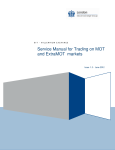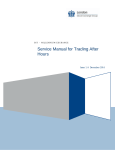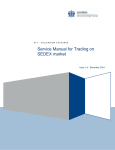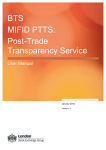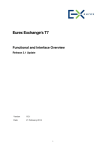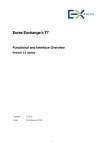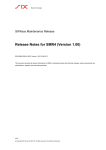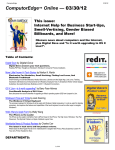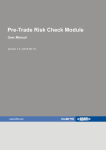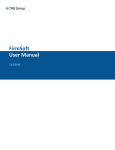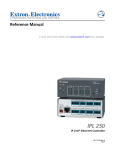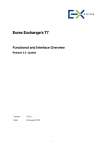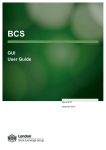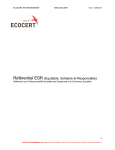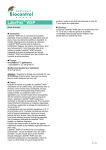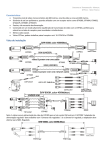Download London Stock Exchange Group product template
Transcript
BIT - MILLENNIUM EXCHANGE Service Manual for Trading on MOT and ExtraMOT markets Issue 1.9 ∙ September 2015 Contents Service Manual for Trading on MOT and ExtraMOT markets ................... 1 Contents ................................................................................ 2 1. Introduction ........................................................................ 5 1.1. Purpose ...................................................................... 5 1.2. Relevant Exchange communication channels .......................... 6 1.3. Document history ........................................................... 7 1.4. Enquiries ..................................................................... 9 1.5. Definitions .................................................................. 10 2. Customer Interfaces............................................................ 12 2.1. Overview ................................................................... 12 2.2. Message workflow ........................................................ 13 2.3. Time synchronisation ..................................................... 14 2.4. Reference Data Service .................................................. 15 2.5. Technical details .......................................................... 15 3. Market Structure ................................................................ 16 3.1. Instruments classification ................................................ 16 3.2. Technical operation parameters ........................................ 18 3.3. Symbology ................................................................. 19 3.4. Operation of the Market .................................................. 20 3.5. Trading Sessions.......................................................... 20 3.5.1. The auction phases ................................................. 22 3.5.2. Auction extensions .................................................. 24 3.5.3. Antispoofing mechanisms during auctions ....................... 24 3.5.4. The continuous trading phases .................................... 25 3.6. Trading price monitoring and volatility auction ....................... 25 3.6.1. Price Bands .......................................................... 26 3.6.2. Price Monitoring Extensions........................................ 27 3.6.3. Circuit Breakers ...................................................... 27 4. User Configuration ............................................................. 28 4.1. Participant Structure ...................................................... 28 4.2. User configuration levels ................................................. 28 4.3. Roles........................................................................ 30 5. Orders and Quotes ............................................................. 31 5.1. Order types ................................................................ 31 5.1.1. Order entry fields .................................................... 32 5.1.2. Time in Force......................................................... 35 5.1.3. Order Type / Time In Force combinations ........................ 37 5.1.4. Order Type - Time In Force / Trading Session combinations .. 38 5.1.5. Order Source ......................................................... 39 5.2. Quotes types............................................................... 40 5.2.1. Quote entry fields .................................................... 41 5.2.2. Content of quotes .................................................... 42 5.3. Cross Order types......................................................... 42 2 5.3.1. Cross Order entry fields ............................................ 5.4. Price Format Code (“tick size”) .......................................... 5.5. Order book priority ........................................................ 6. Order Behaviour ................................................................ 6.1. Stop and Stop Limit Orders .............................................. 6.2. Iceberg Orders ............................................................ 6.2.1. Modification of an Iceberg Order / Stop Limit Orders ........... 6.3. Cross Order and Block Trade Facility .................................. 6.3.1. Cross Order behavior ............................................... 6.3.2. Block Trade Facility behavior ...................................... 6.4. Order management ....................................................... 6.4.1. Order modification ................................................... 6.4.2. Exchange deletion of orders ....................................... 6.4.3. Specifying ClOrdID .................................................. 7. Order Book Execution ......................................................... 7.1. Execution Priority ......................................................... 7.2. Execution Criteria ......................................................... 7.3. Self Execution Prevention (SEP)........................................ 8. Closing prices ................................................................... 9. Additional Services ............................................................. 9.1. Drop Copy.................................................................. 9.2. Own Order / Trade Book Download .................................... Appendix 1: Certification Test Programme ....................................... 3 43 43 44 45 45 48 49 50 50 51 51 51 52 52 54 54 54 55 56 56 56 56 58 Disclaimer The London Stock Exchange Group has taken reasonable efforts to ensure that the information contained in this publication is correct at the time of going to press, but shall not be liable for decisions made in reliance on it. The London Stock Exchange Group will endeavour to provide notice to customers of changes being made to this document, but this notice cannot be guaranteed. Therefore, please note that this publication may be updated at any time. The information contained is therefore for guidance only. 4 1. Introduction Following the acquisition of MillenniumIT, the Borsa Italiana planned for the BIT Cash Markets to migrate from the previously used TradElect and Affari trading platforms to Millennium Exchange – the multi-asset class, ultra-low latency platform of MillenniumIT. The first phase of this transition was the migration of the TAH market in early 2012 and in a second phase all the other BIT Cash Markets (MTA, MIV, AIM Italy, ETFplus, MOT, ExtraMOT, SeDeX). 1.1. Purpose The purpose of this document is to describe the specifics of the MilleniumExchange platform for the following markets and multilateral trading facilities organised and managed by Borsa Italiana S.p.A. MOT ExtraMOT All the technical documents should be read in conjunction with the Rules, Instructions and Guide to Parameters of Borsa Italiana. 5 1.2. Relevant Exchange communication channels Rules of Borsa Italiana The full current Rules of Borsa Italiana in force can be found at: Italian Version: http://www.borsaitaliana.it/borsaitaliana/regolamenti/regolamenti/regolamento borsa-istruzionialregolamento.htm English Version: http://www.borsaitaliana.it/borsaitaliana/regolamenti/regolamenti/regolamento borsa-istruzionialregolamento.en.htm Changes to the Rules of Borsa Italiana and other key regulatory announcements are made by Stock Exchange Notice. Stock Exchange Notices To sign up to E-mail notification of future Borsa Italiana Notices and view the library of previous ones please see: https://www.borsaitaliana.it/borsa/user/registration.html Trading Services webpage More details of the Exchange’s Trading Systems, including where this document and the Millennium Exchange Business Parameters for BIT document will be found following go-live can be seen at: Italian Version: http://www.borsaitaliana.it/borsaitaliana/intermediari/gestionemercati/migrazionemillenniumit-mit/millenniumitmigration.htm English Version: http://www.borsaitaliana.it/borsaitaliana/intermediari/gestionemercati/migrazionemillenniumit-mit/millenniumitmigration.en.htm . . 6 1.3. Document history This document has been through the follow iterations: Issue Date Description 1.0 June 2012 First issue of this document published via the Borsa Italiana’s website and distributed to customers 1.1 June 2012 Section 1.5 updated 1.2 June 2012 ExtraMOT related information specified 1.3 July 2012 Sections 5.2, 6.3 updated 1.3b July 2013 Appendix 1 added 1.4 November 2013 Section 5.2 updated Section 7.3 added 1.5 May 2014 Section 1.5, 2.1, 2.5, 3.1 updated 1.6 December 2014 Updated naming for Market Data Service (MITCH) 1.7 March 2015 Updated sections 2.5, 6.2 1.8 July 2015 Certification Test Programme Updated 1.9 September 2015 Updated sections 2.5, 3.5.3, 5.3, 6.3 7 In subsequent issues, where amendments have been made to the previous version, these changes will be identified using a series of side bars as illustrated opposite. 8 1.4. Enquiries Please contact either Client Technology Services or your Technical Account Manager if you have any functional questions about the Millennium Exchange services outlined in this document. Client Technology Services (ITA) can be contacted at: Telephone: +39 0272426409 - 348 – 606 – 647 Service Desk Free Toll Number: 00800 26772000 Email: [email protected] ; [email protected] Please contact your Business Account Manager if you have any questions about the Millennium Exchange trading functionalities outlined in this document. Business Account Managers (ITA) can be contacted at: ETFplus / MOT / ExtraMOT / SeDeX Telephone: +39 0272426517 9 1.5. Definitions Acronym/Term Better prices (Orders at ...) Explanatory text of the definition means, with reference to the price of a given order: a) any higher price if the order is an order to buy; b) any lower price if the order is an order to sell; Analogously, worse prices are lower prices if the order is an order to buy and higher prices if it is an order to sell. Borsa Italiana means the market management company “Borsa Italiana S.p.A.”; Cassa di Compensazione e Garanzia or CC&G means the company that operates the clearing and guarantee systems; Continuous trading the method of trading that provides for the entry, modification and deletion of orders for the purpose of concluding contracts, immediately or in the future; Default means the valuation of a parameter accepted by definition if not otherwise specified with the entry of a specific value; Executable quote means the order type which is to be used by specialists to fulfil their obligations under Market Rules. This order type allows users to insert a buy order and a sell order with a unique transaction EMS (Exchange Market Size) means the quantity, defined in terms of nominal value for MOT and ExtraMOT, fixed for each security. Borsa Italiana calculates and publishes on its website the EMS for each financial instrument; FIX the Financial Exchange messaging standard GTP the market data service, multicast, GTP Lite the market data service, over tcp-ip MITCH the legacy Market Data protocol over the multicast Market segment means the division of the financial instruments into homogeneous groups in terms of trading methods and hours; Markets means the regulated markets and MTFs organised and managed by Borsa Italiana S.p.A.; Minimum lot means a quantity fixed for each security; orders must be equal to or a multiple of the minimum lot; Opening auction the method of trading that provides for the entry, modification and deletion of orders in a given interval (pre-auction) for the purpose of concluding contracts at a single given future moment (the opening) and at a single price (the opening-auction price or opening price); Opening-auction price” or markets, the price at which contracts are concluded in the 10 “opening price opening phase; if the opening auction price is not determined, the opening price is equal to the price of the first trade executed in the continuous trading phase Order means an order to buy or sell, for own or customer account, entered by approved intermediaries, containing the data and information necessary for its display and execution; PTTS Post Trade Transaction Service Tick means the minimum difference between the prices of orders, established in the Instructions, for each financial instrument traded in the markets; TIF Time In Force: the time validity of the order/quote X-TRM means the post-trading service by means of which transactions involving financial instruments are sent to the settlement service operated by Monte Titoli S.p.A. 11 2. Customer Interfaces In the interest of increased performance and flexibility a new approach to customer interfaces will be introduced which is described below. 2.1. Overview The following interfaces and protocols will now be available to participants Trading Interface order / quote entry and immediate confirmation of automated trades Post Trade Interface ‘Enriched’ trade confirmation of automated trades (including cancellations)1 Off Book Trade Reporting (Post Trade Transparency) Own Trades Book Download (OTBD) Drop Copy Interface ‘Copy To’ functionality Own Order Book Download (OOBD) Market Data Dissemination interface multicast (GTP, MITCH) Market Data Dissemination tcp-ip (GTP Lite,) Reference Data Service With the introduction of Millennium Trading System, the Exchange will standardise on FIX 5.0 SP2 for all of the above customer interfaces with the exception of Reference Data Service2. In addition a new fixed width Native interface will be introduced for the Trading Interface only. Participants will connect to each interface via a FIX or native Gateway, depending on the functionality they require. 1 2 FIX Trading Gateway Native Trading Gateway FIX Drop Copy Gateway FIX Post Trade Gateway Including any Exchange initiated cancellations Will be supported via FTP and SFTP 12 Furthermore, Market Data will be available via the following services.3 GTP Market Data Service; MITCH Market Data Service; GTP Lite Market Data Service; 2.2. Message workflow Participants must use the Trading Interface (FIX or native) to send order, cross order and quote messages to Millennium Exchange via configured Users. In response, Millennium Exchange will send Execution Reports over the interface used giving the status of the order / executable quote. Should a trade occur then the order / quote status will be immediately updated by an Execution Report4 sent from the Trading Interface over the participant connection that sent in the order / quote. In addition to order status the Execution report will summarise the details of the trade and provide among the others the following information: Side Trade Quantity Trade Price Clearing House defined as Counterparty or Counterparty to the Trade Trade ID Order ID Transaction Time In addition, an ‘enriched’ Trade Capture Report will be sent via the Post Trade Interface. This will include the trade details specified in the Execution Report as well as the following information: ISIN Matching Type (Continuous Trading or Auction) Clearing Type (is the trade cleared or not) This means that participants will receive two messages notifying them of the trade. They will be free to choose which message to act on before submitting the next message. Participants will be able to link the Execution Report and Trade Capture Report using either the ExecID or ClOrdID tags. 3 MITCH support will be ceased once GTP / GTP Lite will be rolled out to all customers. Please refer to http://www.londonstockexchange.com/products-and-services/millenniumexchange/documentation/documentation.htm for further details Phase out plan will be communicated in due course. 4 Note – for Executable Quotes two Execution Reports will be sent – one for each side of the Quote 13 Participants should note: In normal circumstances the Trade Capture Report will be delivered after the Execution Report. Execution Reports will be sent to the CompID that sent the order or quote. Customers have the option to cancel at firm level so a "master" CompID could cancel all orders entered for the firm by all other CompIDs. Orders / quotes sent via one CompID cannot be modified or cancelled using another CompID (with the exception of “master” CompID cancellations). A new cancel on disconnect facility has been provided as a means of managing orders if a session is lost. See MIT201 BIT - Guide to New Trading System for more details. A Post Trade / Drop Copy User can be configured to receive all Trade Capture Reports / Execution Reports for the Firm, or selected CompID / UserID. Customers are recommended to have a separate connection to the Post Trade Gateway for Off Book Trade Reporting, Real Time Trade Capture Reports and the OTBD service. Where a customer is using ‘Copy To’ functionality, a separate connection to the Drop Copy Gateway will be required over and above that used to support the OOBD service. 2.3. Time synchronisation As per the FIX standard, all times on FIX trading messages must be specified in UTC. Customers are recommended to use the Sending Time in the FIX logon message sent by Millennium Exchange to synchronise system clocks. Also all times on Native messages are in UTC. 14 2.4. Reference Data Service Reference data will be managed by a new Reference Data Service that will provide instrument reference data to participants in a new ‘flat file’ format and available via FTP. Full details of the interface are specified in the document “MIT305 – BIT Markets Reference Data and FTSE indices constituents”. In addition to the flat file a subset of reference data will be available via the Market Data feed each morning: Symbol (unique identifier) Instrument status ISIN Segment Tick Price Bands Tolerances Dynamic Circuit Breaker Tolerances Static Circuit Breaker Tolerances 2.5. Technical details Technical details of all interfaces are provided in the following documents: MIT201 BIT - Guide to New Trading System MIT202 BIT - Trading Gateway (FIX 5.0) Specification MIT203 BIT - Native Trading Gateway Specification MIT204 BIT - Post Trade Gateway (FIX 5.0) Specification MIT205 BIT - Drop Copy Gateway (FIX 5.0) Specification MIT301 BIT – Guide to Market Data Services MIT303 BIT - Level 2-MITCH Specification MIT305 BIT – Markets Reference Data and FTSE indices constituents MIT306 BIT – FTP Services MOT Instrument Currency Specifications MIT308 BIT – Trading Calendars GTP002 – Technical Guide GTP007 – GTP Lite Guide 15 3. Market Structure 3.1. Instruments classification From a business perspective an individual instrument is assigned to a grouping to form a trading segment. A specific Trading Service is a number of trading segments that share the same market model. The Millennium Exchange Business Parameters for BIT Document maps these exact groupings and allows us to lay down criteria that operate at each specific grouping level. The sector identifies a set of securities within a segment, characterised by common trading mechanisms (e.g. shares included in the FTSE/MIB index or STAR shares). The technical definition of market, segment and sector may differ from the corresponding regulatory criterion. Table 1 shows the structure envisaged for the Italian MOT - ExtraMOT markets. 16 MARKET SEGMENT CODE SEGMENT DESCRIPTION SECTOR CODE MOT DMO ITALIAN GOVERNMENT BONDS ICC ITALIAN CORPORATE B.CLEAN ICD ITALIAN CORPORATE B.DIRTY IGC ITALIAN GOVERNMENT B.CLEAN IGD ITALIAN GOVERNMENT B.DIRTY IGQ ITALIAN GOVERNMENT QUOTE CBQ CORPORATE BONDS IN PUBBLIC OFFER ESC EUROMOT STRUCT B.-CLEAN ESD EUROMOT STRUCT B.-DIRTY EVC EUROMOT VANILLA B.CLEAN EVD EUROMOT VANILLA B.-DIRTY EBQ EURO BONDS IN PUBBLIC OFFER USC UNREGULATED STRUCT B.-CLEAN USD UNREGULATED STRUCT B.-DIRTY UVC UNREGULATED VANILLA B.CLEAN UVD UNREGULATED VANILLA B.-DIRTY EMO UMO OP2 EUROMOT VANILLA BONDS UNREGULATED STRUCTURED BONDS TAKE OVER BIDS (MOT) 17 TORM SECTOR DESCRIPTION TOB ROLLING (MOT) TOAM TOB ACCOUNTING (MOT) Table 1: Market structure for MOT – ExtraMOT For updates, please refer to: MIT305 - FTP Services Reference Data Specification N.B. The configuration and the acronyms used in the table for the market models, segments and sectors above are indicative and may undergo changes, which will be announced subsequently. 3.2. Technical operation parameters The sectorisation documented above has been maintained to ease transition to Millennium Exchange and to maintain categorisations from an Exchange Rules and wider regulatory perspective that are not specifically relevant to the trading system. Trading segments and trading sectors are not key fields for Millennium Exchange trading message entry. They will however, continue to be defined and provided via the Reference Data Service. In Millennium Exchange, instruments are technically structured as follows: Each instrument will be assigned to a Market and Segment Instruments are assigned to an Order Book with a pre-determined Trading Cycle Instruments will have specified instrument, Trading and Post Trade parameters assigned that dictate how the instrument is traded A Trading parameter consists of session parameters and a price tick table A Post Trade parameter consists of trade types and delay model (PTTS) 18 Figure 1 – Technical structure of an instrument on Millennium Exchange 3.3. Symbology A new, more efficient, approach will be taken to the identification of trading instruments. The “4 way key” is no longer supported and an instrument must now be identified on trading messages using a unique InstrumentID.5 The InstrumentID will remain constant for the lifetime of the instrument, even if data pertaining to that instrument changes. However participants should note that in some cases (i.e.: corporate action).an instrument will continue to be deleted and re-added should the ISIN be changed. The Exchange will provide InstrumentIDs via the Reference Data Service and over the Market Data Feeds. Even though the same security trades in MOT/ExtraMOT and supports reporting via PTTS Service, it will be managed as different instruments for MOT/ExtraMOT and PTTS Service, with different instruments IDs, different Symbols but with same ISIN code Full details are specified in the Technical Details documents. 5 Specified in Tag 48 – SecurityID on FIX and Native messages 19 3.4. Operation of the Market The base microstructural models for MOT and ExtraMOT consist of auction phases and continuous trading phases. The models above are applied to the individual segments, following a succession of trading sessions, as outlined in the Millenium Exchange Business Parameters document. 3.5. Trading Sessions Although there will continue to be a concept of ‘Period’ (or ‘Sessions’ on Millennium Exchange) the general approach to trading sessions will be simplified. Each instrument will generally follow a simple trading day consisting of an opening auction, continuous trading and a closing auction where applicable. Timings and associated trading parameters will vary according to the market model and will be communicated in due course. In addition, and as today, market control actions invoked by the Exchange will potentially override the normal schedule. As an instrument moves from one trading session to another the new Millennium Exchange Information system will disseminate the new status of that instrument via the security status message. Please see MIT303 BIT - Level 2-MITCH Specification for further information. The following possible status will be sent The possible following status will be sent (marked with * the possible statuses for MOT ExtraMOT ): Pre Trading (Start of Trading)* Opening Auction Call* Continuous Trading* Close Auction Call Closing Price Publication* Re-Opening (AESP or Resume) Auction Call * Resume Order Deletion period* Halt* Trading Stop* Market Closed* Post Close* End of Post Close* 20 No Active Session* OPA Auction Call Start of Trade Reporting End of Trade Reporting The specific –and up to date- schedule for each segment is available in the “Millenium Exchange Business Parameter” document. 21 3.5.1. The auction phases During the trading day, compatibly with the microstructural model chosen for each market sector, there can be three different types of auction phase, i.e. opening, closing and volatility, which are divided into the period sequences shown below. Type of auction Sequence of periods Opening auction Opening auction call Opening auction Re-Opening auction Re-Opening auction call Re-Opening auction Figure 2: Type of auction and sequence of periods Auctions themselves are not sessions but time based event triggers The maximum random time to perform the auction from this time will be defined in the trading parameter MAXIMUM RANDOM DURATION (60 seconds). In the auction call periods participants may enter, modify and delete their orders, which contribute to the determination of the indicative auction price according to the rules set out below. 22 Determination of the indicative auction price (PTA) The execution price generated for an auction will be as follows: Step 1 - The auction price will be the price at which the largest number of instruments can be executed. I.e. The price at which volume is maximized. Step 2 - If the volume is maximized at multiple prices then the auction price will be the price at which the Order Imbalance6 is minimized. The Order Imbalance at a particular price will be the difference between the following two quantities: for the buy side the aggregate quantity of all the Market Orders as together with all the Limit Orders’ having a price greater than or equal to the price being considered; for the sell side the aggregate quantity of all the Market Orders as together with all the Limit Orders’ having a price less than or equal to the price being considered. Step 3 - If the Order Imbalance is minimized at multiple prices then the concept of Market Pressure will be used. Market Pressure will be calculated as follows: if all the prices at which the Order Imbalance is minimized have a buy imbalance, then the highest price will be the auction price. (An Order Imbalance on the buy side means there will be a remaining quantity in the buy side; this remaining buy pressure is likely to cause the price to rise after the auction; hence the highest price is taken); if all the price points at which the Order Imbalance is minimized has a sell imbalance, then the lowest price will be the auction price (an Order Imbalance on the sell side means there will be a remaining quantity in the sell side; this remaining sell pressure is likely to cause the price to fall after the auction; hence the lowest price is taken); if the prices at which the Order Imbalance is minimized have buy and sell imbalances, then the highest price out of the prices with buy imbalances and lowest price out of the prices with sell imbalances will be chosen. Step 47 - If step 3 resulted in two prices then the auction price is determined as below: if the STATIC Reference Price is equal or greater than the highest price, then the highest price is chosen as the auction price; if the STATIC Reference Price is equal or less than the lowest price, then the lowest price is chosen as the auction price; if the STATIC Reference Price is in between the two prices, then the STATIC Reference Price is chosen as the auction price. The activities of entering, modifying and deleting orders in auction call periods end at a time in an interval of at most 60 seconds. After that time determined automatically by the system on a random basis and until the end of the auction phase, participants may use only the information functions 6 During any of the auction call sessions (which can be Opening, Closing, etc) the imbalance quantity and the imbalance side will be disseminated via the market data feeds 7 This is a different step introduced with MIT Trading 23 If the auction price is validated, there is the shift to the corresponding auction period, in which the system verifies whether the orders on the trading book can be executed. Orders are executed when: ־there are one or more market buy orders and one or more sell orders of any type; or ־there are one or more buy orders of any type and one or more sell market orders; or ־if there are no market orders on the book, there are one or more buy orders at prices equal to or higher than those of the sell orders; and ־if the indicative auction price is valid, i.e. falls within the price tolerance limits set for the auction phase (see Section 2.3.2). If the opening or closing indicative auction price is validated, trades are executed at a single price (the auction price) by the matching of compatible orders of opposite sign entered during the auction call periods. The trades execution order is based on the price priority rule and, if the price is the same, in rising order of entry time (so-called price then time priority). 3.5.2. Auction extensions The reiteration of the auction phases subsequent to a failure to validate the indicative price follows a different procedure for the opening auction and the closing auction: - at the end of the opening auction, the reiteration of the auction phases subsequent to a failure to validate the indicative price is carried out an indefinite number of times, i.e. throughout the period in which the indicative price continues not to be validated during the trading session; each of this sessions will last 10 minutes. The indicative auction price is updated and disseminated in real time whenever it changes as a consequence of orders being entered, modified or deleted. 3.5.3. Antispoofing mechanisms during auctions In order to improve the price discovery process and to avoid conduct involving the issue and cancellation of orders for large quantities, designed to influence auction price formation at the end of a session, so-called antispoofing mechanisms have been introduced to monitor the trend of the key defining elements of the book (indicative prices, tradable volumes and corresponding variations) in the last seconds of the auction phase. The process applies all auctions (opening, closing and volatility) and it postpones closure by few moments only in case of successful verification and it would be reiterated several times until the end of the time scheduled for the end of the auction. 24 The final validation period duration and the stability criteria of indicative auction prices and corresponding volumes are established in the Guide to the Parameters. 3.5.4. The continuous trading phases During the continuous trading phase, participants may: - enter, modify and delete orders; - match orders entered by other participants; - use the information functions. In this phase each incoming order is immediately assessed against the existing orders to verify whether execution can occur. For each security orders are executed when: - the price of an incoming sell order is equal to or lower than the highest price of the buy orders on the book; or - the price of an incoming buy order is equal to or higher than the lowest price of the existing sell orders. The sequence in which orders are executed is based on the price and then entrytime priority rule. The price at which orders are executed is determined by the prices of the existing orders, since they have a higher time priority, and is limited by the price of the order entered. More specifically, for each security the system automatically matches orders, executes the related trades and then generates and automatically sends the corresponding trade confirmations. Existing orders that are modified so as to improve their price priority are reassessed by the system against the other orders on the book and may give rise to trade execution. The continuous trading phase may be interrupted with the simultaneous activation of the Re-Opening auction phase if trades show excessive price variations. 3.6. Trading price monitoring and volatility auction Order books can be subject to rapid price movements. Millennium Exchange operates price monitoring functionality that tracks the prices at which automatic executions are due to occur and will halt continuous trading / delay an auction execution if certain price movement tolerances would be breached. The presence of price monitoring functionality in Millennium Exchange does not remove the requirement for participants’ systems to have adequate safeguards in place to avoid erroneous order inputs. 25 3.6.1. Price Bands Price bands are defined based on an upper and lower demarcation based on the Static Reference Price and if it does not exist the price bands will not be computed. Upper Price Band Static Reference Price Lower Price Band The static reference price is the most recent auction price8 from the current day. Where the most recent auction did not generate an execution, it will instead be the first automated trade that followed the previous auction period. Against the Static Reference Price, the offset will be defined as a percentage. Price bands validation is applied, during all the trading sessions, at the below scenarios: Entry of a new order Amendment to an existing order An injection of an already parked order to the order book (for example after a parked Stop/Stop Limit order is injected). Price bands do not apply to Market orders. They are only applied to Limit, and Market to Limit (when injected) orders as well as to Quotes. Limit orders and quotes will be rejected due to the following conditions: Buy order or an amendment to a buy order whose prices are greater than the Upper Price Band or less than the Lower Price Band. Sell order or an amendment to a sell order whose prices are greater than the Upper Price Band or less than the Lower Price Band. Quotes which have either a bid or offer price that violates the Upper or Lower Price Bands. Limit orders and Quotes with limit prices equal to the price band price are permitted. 8 This would not be applicable to the Markets Models where is not defined the auction 26 If the GTC/GTD orders, carried forward from the previous day, are priced away from the price bands, those should be expired before the beginning of the trading (this will be done at the Market Open). The Execution Report published to report the expiration should contain the reason “Expired (price band breached)”. Price bands will be set up at the individual instrument level. Market supervision can switch off price bands validation if required intra-day and can change the price bands intra-day as well. 3.6.2. Price Monitoring Extensions A price monitoring extension is triggered when at the end of the call period (or any preceding auction extension period) the indicative auction match price is greater than a configured tolerance away from the Static Reference price. The price monitoring extension consists of an extension to the auction call period of a configurable amount of time. The extra time a price monitoring extension provides draws attention to a potential price movement, giving participants the chance to review the prices of the orders that have been entered and if appropriate add, delete or amend 3.6.3. Circuit Breakers Circuit breakers will be evaluated against both static and dynamic reference prices for ExtraMOT instruments, against static reference price only. Incoming order that triggers circuit breaker tolerance limits will not be expired and added to the order book (as the instrument moves in to an AESP (Re-Opening) Auction). It should also be noted that: Fill or Kill (FOK) orders do not lead to the execution of trades if the volatility auction phase that they would trigger as a consequence of a permitted maximum or minimum price level being reached intervenes before they are fully executed; Immediate or Cancel (IOC) orders that activate a volatility auction phase by attempting to go above or below the limits are executed in part up to the minimum or maximum price permitted by the parameters established. Any unfilled quantity is eliminated before the passage to the volatility auction phase. If a circuit breaker is triggered in continuous trading, instrument will move to a AESP (Re-Opening) Auction Call session, where trader groups of member firms can enter, amend and cancel orders/quotes; also when moving to Re-Opening Auction Call, all existing Iceberg Orders will be expired and no new Iceberg Orders will be accepted. After the defined time duration, the AESP (Re-Opening) Auction will be performed and the instrument will be moved back to Continuous Trading session. 27 4. User Configuration 4.1. Participant Structure Millenium Exchange provides an optional hierarchical structure on three levels for market participants. More specifically, each intermediary can develop its access to the market, taking account of the following: Firm; Node; User. The structure of participants’ access to the market can therefore be personalised on the basis of the three levels described in Figure 2 below. To this end intermediaries will have to provide Borsa Italiana with details of their own personalisation (the ramification of one or more User codes, with the related User ID codes), on the basis of what established at the regulatory level. 4.2. User configuration levels Generically, a 3-tier hierarchy will be introduced consisting of Firm, Node and User. Each User will have an associated Role. 28 Firm (Member ID) Node FIX Trading Gateway (CompID) Trading Party (Trader Group) Entered via FIX Trading Gateway Native Trading Gateway (UserID – / TraderGroup are interchangeable) FIX Post Trade Gateway (CompID) FIX Drop Copy Gateway (CompID) Figure 3 – User hierarchy With reference to the diagram above, please notice that A Firm represents the highest level when depicting a participant and is intended to represent the membership under which business is routed to the Exchange. The Firm is identified by a unique Member ID; A Node represents a logical grouping of Users (see below), this is a new concept that forms part of the core Millennium Trading product, it allows customers a degree of further classification/segmentation within their business, for example a firm with different clearing arrangements can segment its business accordingly; A User represents a generic business or technical enablement, such as a trading desk or a FIX Gateway. The exact type of User is defined by the associated Role. The same User can only be configured under one node. The User can only have one of the Roles outlined below. For the technical detail of Users, broken according to the used interface, please refer to MIT201 – BIT – Guide to New Trading System. With special reference to the User, it should be noted that the above-mentioned level of detail can be used by the members of Borsa Italiana for various purposes. For 29 example, an intermediary could develop its structure of access to trading on the basis of one or more Users to identify homogeneous trading desks such as, for example, arbitrage desks, desks for trading on behalf of customers interconnected via the Internet and those for customers that use automated trading systems; to segregate the trading of different branches belonging to the same legal entity; or to meet any other need of the market participant. In addition, on the basis of what has been set out above, access and control are carried out at User (TraderGroup/CompID) level with the Millenium Exchange platform. Borsa Italiana therefore invites all its participants to give careful consideration to their market participation structure. More specifically, intermediaries should use the trading access configuration (Member ID, one or more Node, one or more CompIDs/TraderGroups) best suited to their needs, regarding both trading business and control. Borsa Italiana reserves the right to request participants to adopt a particular configuration on the basis of regulatory and technical assessments. The introduction of the Node and CompID/Trader Group permits a better management of platform messages. Participant should note that the access to the Borsa Italiana Markets will be defined as follows: - Users dedicated to a specific Market (i.e. Users dedicated only to MTA, Users dedicated only to ETFplus, etc.); each user can connect to a single Market 4.3. Roles Market participants can configure the use of Millenium Exchange™ using a system based on roles. A role is a defined set of activities that each Trader Group assigned to that role can undertake on the platform. Among other things, the activities that can be assigned to each role include: the ability to enter orders and the use of specific order types (e.g. quotes or named orders); the ability to enter quotes and the use of specific quote types. Each Trader Group is assigned a specific role. Accordingly, if a participant has configured its access structure using a Member ID and just one Trader Group, the latter will have at least one role. 30 Specific roles can be assigned at a segment level or at the level of tradable instrument (e.g. the ability to submit orders or quotes as a specialist for a given security). The roles associated with the level of tradable instrument are disclosed to the market. In this respect, although roles are defined at the level of Trader Group, the information disclosed to the market will regard the intermediary’s entire Member ID. Accordingly, if a Member ID is subdivided into many Trader Groups, the information disclosed to the market will take account of all the roles of the Trader Groups belonging to that Member ID. 5. Orders and Quotes The majority of trading functionality related to orders and quotes offered by TradElect will continue to be supported by Millennium Exchange. Today, the behaviour of an order or quote is defined by a combination of its Order Type (Market Mechanism on TradElect) and its time in force. This underlying concept will continue to be supported on Millennium Exchange, but with some differences described in the following section. It should be noted that the Order Types are not explicitly stated on FIX and Native messages, but are defined via a combination of tags. Please see the Technical Details documents for further information. 5.1. Order types The existing TradElect Order Types will continue to be supported on Millennium Exchange and it will be possible to enter further new order types. Table below summarises the Order Types supported on Millennium Exchange: Order Type Description Limit Order A limit order is an anonymous priced order that is fully displayed when persistent in an order book and may execute at prices equal to or better than its limit price. Limit orders never have price priority over market orders. Market Order A market order is un-priced, and therefore not price forming, but has price priority over all priced orders. Market orders cannot persist on the order book during continuous trading, therefore only market orders with non-persistent time in force can be entered during this period. Persistent market orders can be entered during auctions and will display on the order book during an auction. Any that remain unexecuted following the completion of the auction will be automatically deleted. 31 Market to Limit A order that will execute at the best available prices until it is filled. Any remainder will be converted to a limit order at the last traded price. 9 A Market to Limit Order will aggress the system as a Market Order during an Auction Call and participate in the auction. At the end of the uncrossing, if there is left over quantity with the order, it will be converted to a Limit Order at the auction price. If the uncrossing did not happen then the Market to Limit Order will still be converted to a Limit Order at the Static Reference Price of the instrument. Stop Limit Orders A Stop Limit Order is a Limit Order that will remain unelected (will not be entered into order book) until the stop price is reached. Once elected, a Stop Limit Order will be treated similar to a regular new Limit Order. The trigger for electing Stop Limit Orders is based on the Last traded price Stop Limit Orders will not be enabled for MOT - ExtraMOT at the start of trading on Millennium Exchange; any change will be announced in due course. (Not available on MOT – ExtraMOT) Stop Orders A Stop Order is a Market Order that will remain unelected (will not be entered into order book) until the stop price is reached. Once elected, it will be treated similar to a regular new Market Order. The trigger for electing Stop Orders is based on the Last traded price. Stop Orders will not be available for MOT ExtraMOT at the start of trading on Millennium Exchange; any change will be announced in due course (Not available on MOT – ExtraMOT) Iceberg Orders An iceberg order publicly displays only a portion of its total volume that is available for execution. The maximum displayed amount, known as the peak size, and the total size of the order can be specified by the participant and must be above specified minimums. Named Orders A named order is a non-anonymous limit order available on certain Trading Services only. These orders can be entered by Specialists. Table 2 – Order Types 5.1.1. Order entry fields The following table shows which fields are mandatory and which are optional for a Millennium Exchange Order. 9 Field Instrument Required Yes Description The unique identifier of the security. Possible Values Side Yes Whether the order is to buy or sell. - Buy - Sell Order Type Yes the type of the order - New Order type introduced with Millennium Trading System 32 Market Market to limit Limit Iceberg Time in force No The duration the order is valid for. If the time in force is not stated, the system assumes it to be a DAY order. Even if it’s not a TIF parameter, in this section it’s highlighted that on MIT Trading it’s possible to set the parameter “Auto Cancel Orders on Disconnect” to specify if the order should be cancelled in case of disconnection - DAY - IOC - FOK - OPG 10 - GTD /GTT - GFA Expiry Time Required if time in force = GTT The time at which an order with GTT order should expire Expiry Date Required if time in force = GTD The date on which an order with GTD order should expire For ExtraMOT, the only admitted Expiry Date is the current trading date. Order Quantity Yes The quantity being bought or sold. This should be a whole number that is greater than zero. Disclosed Quantity No The maximum quantity, if any, that may be displayed. This should be a whole number. For Iceberg Orders, this will be greater than zero but less than the order quantity. For Limit Orders, this will be the same as Order Quantity. Price No The maximum/minimum price a buy/sell order may be executed at. This value should be greater than zero and a multiple of the instrument’s ‘Tick’. This field is required if the order is a Limit or a Stop Limit Order. Stop Price (Not supported on MOT – ExtraMOT) No The price at which the order may be elected. This value is required if the order is a stop or stop Limit Order. This value should be greater than zero and a multiple of the instrument’s ‘Tick’. Capacity Yes Denotes if the order is entered as an ‘Agency’ (on behalf of a client), ‘Principal’ (own account) Trading Party Yes The trading party of the order is identified by this field. For Exchange users this will be the trader group Client Reference No This will be the client reference of the order Clearing Account Yes Identifies the clearing account for the order - Client - House Pre Trade Anonymity No Whether the order is anonymous or named - Anonymous - Named 10 GTT must be specified in UTC 33 - Agency - Principal Order 11 Source Yes Defines the source of the incoming order ExecInst No Specifies if the order has to be cancelled upon a disconnection or a log out. The absence of this field is considered as that the member firm wants to go ahead with the user level configuration in the system for its orders. It should also be noted that a member firm can only override the user level configuration of cancel on disconnection/log out by indicating not to do so for some specific orders. - Authorized Direct Member - Institutional Client Interconnected - Private Client Interconnected - Branch - Retail Trading Online Table 3 – Order entry fields Following tables specify the FIX tags and Native fields that should be used to define each order type. FIX Tag Order Type Limit Order Market Order Market to Limit Named Limit Order Iceberg Order Order Type 2 1 K 2 2 Anonymity 12 Y Y Y N Y Display Qty TotalQty TotalQty TotalQty TotalQty 13 Peak Size Table 4 – FIX Tags 11 12 13 It should be noted that, the source of the incoming order can only be specified for orders. It is not applicable for quotes. Absence of this field is interpreted as Anonymous See Millennium Exchange Business Parameters for minimum size 34 Native Field Order Type Order Type Limit Order 2 Market Order 1 Market to Limit 5 Named Limit Order 2 Iceberg Order 2 Table 5 – Native Fields Anonymity 0 0 Display Qty TotalQty TotalQty TotalQty 1 0 TotalQty 14 Peak Size Full details of FIX tags and Native fields are provided in MIT202 – Trading Gateway (FIX 5.0) Specification and MIT203 – Native Trading Gateway Specification. 5.1.2. Time in Force The current TradElect Validity types will be supported on Millennium Exchange and mapped to FIX Time In Force (TIF) enumerations. However there are some minor differences in the impact of certain Time in Forces on order behaviour when compared to TradElect: Expiry times can no longer be specified for a GTD order. All orders with a GTD Time In Force will be deleted at the end of trading on the date of expiry (or following business day if a closed date) GTD orders will be disabled for ExtraMOT securities. Any GTT orders with an expiry time during any auction call phase will not be deleted until after uncrossing has completed and are therefore eligible to participate in that uncrossing. To avoid possibility of execution in this scenario, a participant is required to manually delete their orders. Subject to above, GTT expiry times can be specified to the nearest second (TradElect only supports minutes) Orders will only be injected for auctions that day – any orders with a OPG, GFA Time In Force will be deleted at the end of day The GTC Time In Force will not be supported for those markets that have maximum order duration. Any GTD order specified with an expiry date greater than that allowed will be rejected. During auction call sessions, any order (including market orders) with IOC and FOK TIF will be rejected. The following table summaries all the Millennium Exchange Time In Forces. 14 See Millennium Exchange Business Parameters for minimum size 35 Time in Force Behaviour 15 Orders with the DAY time in force will be expired at the end of the trading on the day they are submitted GTC 16 Orders with the GTC time in force will remain in the system until cancelled by the trading party or a market operations user GTD Deleted at the end of trading on the day specified in the order. If the specified day is a non-business day then the order will expire before start of trading on the next business day. DAY Orders with the GTT time in force will expire at the time specified in the order or at the end of the trading day. These orders must contain a valid expiry time that can be specified down to seconds. GTT IOC 17 Any GTT orders with an expiry time during any auction call phase will not be deleted until after uncrossing has completed and are therefore eligible to participate in that uncrossing. Any GTT orders remaining will be deleted at the end of trading day. 18 Executed in full on entry or immediately expired. An FOK order may not be partially filled. FOK OPG Executed on entry and any remaining unexecuted volume deleted. 19 OPG time in force is used to direct orders to the Opening Auction. OPG orders participate in the Opening Auction. The remainder of these orders will expire once the Opening Auction is completed. They will also expire if no uncrossing takes place during the Opening Auction Order rejected if an instrument does not have a scheduled Opening Auction GFA time in force is used to direct orders to the next auction. GFA GFA orders submitted during the Continuous Trading session will be parked until the next auction call period starts at which point they will be injected into the order book. Any remaining volume deleted after uncrossing and they will not be executed during Continuous Trading. If no auctions in a trading day then deleted after end of trading. Table 6 – Millennium Exchange Time In Force 15 Specified as GFD on TradElect Although GTC is technically supported, all current Exchange market models specify a maximum duration for persistent orders of 30 days therefore GTC will not be permitted and the GTD Time In Force should be used. GTC will be used in case of Take Over Bid (OPA) 16 17 GTT must be specified in UTC 18 Immediate or Cancel – equivalent to Execute and Eliminate on TradElect 19 Specified as ATO on TradElect 36 5.1.3. Order Type / Time In Force combinations Table below specifies which combinations of Order Type and Time In Force are valid on Millennium Exchange. Order Type TIF Limit Market IOC Y Y FOK Y Y DAY Y Y GFA Y Y OPG Y Y GTC Y Y GTD Y Y GTT Y Y Table 7 – Order / Time In Force 20 21 MTL N N Y Y Y Y Y Y Iceberg Y Y Y N N Y Y Y Named Y Y Y Y Y Y Y Y Quote N N Y 20 Y 21 Y N N N Participants should note that this parameter is admitted only during the auction call Participants should note that this parameter is admitted only during the auction call 37 5.1.4. Order Type - Time In Force / Trading Session combinations Order Type TIF Table below specifies which combinations of Order Type ,Time In Force and Trading Sessions are valid on Millennium Exchange. Trading Sessions Opening/ Reopening Start of Trading Auction Call IOC N N FOK N N DAY N Y GFA N Y OPG N Y*** GTC N Y GTD N Y GTT N Y Market N Y Limit N Y Iceberg N N Named N Y Quote N Y MTL N Y Resume Continuous Auction Trading Call Y N Y N Y Y Y** Y N N Y Y Y Y Y Y Y Y Y Y Y N Y Y Y Y N Y Halt N N N N N N N N N N N N N N Post Close N N N N N N N N N N N N N N * Parked or Injected on the Order Book ** Parked *** Valid in case of opening auction call not in reopening Table 8 – Order - Time In Force / Trading Sessions It should be noted that clients can inject Market Orders during Auction Calls with GTD/GTC TIF in order to expire the market orders later (next days), but then, at the end of the Auction (any kind of Auction, Opening, AESP/Re-Opening), the Market Orders are expired by the system. 38 5.1.5. Order Source The market participant, when entering the order, should indicate in the apposite field an identification code that differs depending on the order source. The classification is based on the type of order source, in the interest of which the order is entered in the market and prescinds from the technological solutions adopted for the transmission of the orders (therefore regardless of the utilization of on line trading systems, rather than manual entering of orders and of the utilization or not of computer-based systems for the automatic generation of orders). The admitted codes are the following: Code 1 3 7 8 9 Order source Description Market participant The order source identifies all the that deals on own orders entered in the market for which account the market participant trades against proprietary capital Institutional client of The order source identifies all the the market orders entered in the market on behalf participant of the institutional clients of the market participant Retail client that The order source identifies all the avails itself of an orders entered in the market on behalf orders router of the retail clients of the orders router different from the who accesses to the market through market participant the market participant Institutional client The order source identifies all the that avails itself of orders entered in the market on behalf an orders router of the institutional clients of the orders different from the router who accesses to the market market participant through the market participant Retail client of the The order source identifies all the market participant orders entered in the market on behalf of the retail clients of the market participant It should be highlighted that: - institutional clients mean: the subjects referred to in Annex II, Part 1 of Directive 2004/39/EC (MiFID) - retail clients mean: the subjects who are not institutional clients orders routers: the subjects which are authorised for the reception and transmission of the orders (such definition includes also chains of intermediaries). 39 5.2. Quotes types Executable Quotes are supported on Millennium Exchange. A quote is a pair of buy and sell interest submitted simultaneously, and managed as a single entity. Quotes are exclusively used by specialists interested in continually maintaining two sided presence in the market. Specialists will enter Named Quotes. Single Quotes are introduced to fulfil single-side (e.g. bid-only) specialist obligations22. Table below summarises the Quote Types supported on Millennium Exchange: Quote Type Description Executable Quotes The Named Quote is fully visible, electronically executable, registered specialist quotes that must meet prescribed size and spread requirements on entry. It’s highlighted that on MIT Trading are admitted the single-sided and the dual-sided quotation. Table 9 – Quote Types A Trading Party can only maintain one quote for an instrument. Hence if a new quote is submitted, it will replace the current quote. However, these same participants (Specialists) might require an additional CompID – generally marked “Z” CompID - to be allowed to send a further-level of Named Quotes, and Named Orders as well, for the same instruments they have Specialist responsibility on. Single-side specialists shall use a dedicated CompID through which they display one quote at a time, in compliance with their single sided quotation obligations. This quote shall be named, have a limit price and have TIF DAY. 22 Following Notice from the Exchange, Single-Sided Quotation will be available to users effective starting from Jan. 13th 2014 40 5.2.1. Quote entry fields The following table shows which fields are mandatory and which are optional for a Millennium Exchange Quote. Field Instrument Required Yes Description The unique identifier of the security. Possible Values Quote Qualifier No Time qualifier of the quote. - OPG (at the open) - GFA (good for auction) If the qualifier in force is not stated, the system assumes it to be a DAY quote. Bid Size Yes Bid quantity. This should be a whole number that is greater than zero. Bid Price Yes Bid Price Offer Size Yes Offer quantity. This should be a whole number that is greater than zero. Offer Price Yes Offer Price Capacity Yes Denotes if the quote is entered as an ‘Agency’ (on behalf of a client), ‘Principal’ (own account) Trading Party Yes The trading party of the quote is identified by this field. For Exchange users this will be the trader group Clearing Account Yes Identifies the clearing account for the quote ExecInst No Specifies if the quote has to be cancelled upon a disconnection or a log out. It should be noted that the above indication should be done in each and every Quote Message for quotes if the member firm wants the existing quote not to be cancelled upon a disconnection/log out. If the indication it is not set in the last quote message sent, any previous indications will be overridden by that and if a disconnection/log out happens the quote will be cancelled provided the fact the user level configuration is set to do so Table 10 – Quote entry fields 41 - Agency - Principal - Client - House 5.2.2. Content of quotes Quote size Both the bid and offered size on a quote on entry must be equal to or greater than the lot size for that specific security to be accepted by the system. As far as quotation quantity obligations are concerned, Specialists should refer to market Rules and Instructions. If the size value is specified as zero for one side, then it will be considered that particular side being not submitted in a SSQ. Maximum spread The spread between the bid and offer prices must be at least one tick size to be accepted by the system. The absolute spread (offer less bid) is divided by the midprice of the spread (offer plus bid, divided by 2) to determine a percentage spread. As far as quotation spread obligations are concerned, specialists should refer to market Rules and Instructions. If the price value is specified as zero for one side, then it will be considered that particular side being not submitted in a SSQ. Quote Qualifier On MIT Trading there can be DAY, Goof For Auction or OPG Qualifiers for quotes. In the absence of a Quote Qualifier, it will be defaulted to DAY. It is not allowed to amend the Quote Qualifier, therefore if the Quote Qualifier needs to be changed, the participant needs to cancel the existing quote and submit a new quote with the new Qualifier. All the remaining quotes will be expired at the end of the trading of the day. 5.3. Cross Order types On Millennium Exchange it will be possible to enter the Cross order types. Table below summarises these further order types supported on Millennium Exchange: Cross Order Type Description Internal Cross A dual sided order, agreed or identified within a single member firm. The price of the order must be within the spread as described in section 6.3. Internal BTF A dual sided order, agreed or identified within a single member firm, that will execute with each other side at a price between visible best bid – a configurable percentage and visible best offer + configurable percentage (including extremes). The percentage will be determined by the Exchange. Committed Cross A single sided order, agreed or identified by two different member firms. The price of the order must be within the spread as described in section 6.3. Committed BTF A single sided order, agreed or identified by two different member firms, that will execute with the other side of BTF at a price between visible best bid configurable percentage & visible best offer + configurable percentage 42 (including extremes). The percentage will be determined by the Exchange. Table 21 – Cross Order Types 5.3.1. Cross Order entry fields The following table shows which fields are mandatory and which are optional for a Millennium Exchange Cross Order. Field Instrument Required Yes Description The unique identifier of the security. Possible Values Cross ID Yes The unique ID of the Cross/BTF Order Cross Type Yes The type of the cross order - Order Type Yes Type of the order - Limit Side Yes Side of the cross order Quantity Yes Order quantity Price Yes Price of the order Capacity Yes Denotes if the order is entered as an ‘Agency’ (on behalf of a client), ‘Principal’ (own account) Trading Party Yes The trading party of the order is identified by this field. For Exchange users this will be the trader group Client Reference No This will be the client reference of the order Clearing Account Yes Identifies the clearing account for the order Internal Cross Internal BTF Committed Cross Committed BTF - Agency - Principal - Client - House Table 32 – Cross Order Entry Fields Only TIF = DAY is allowed for Cross Orders. 5.4. Price Format Code (“tick size”) The Price Format or tick size is the minimum valid increment in which order and quote prices can be entered and displayed. Each tick size is a numeric amount, which is the minimum part of the percent-base expressed price for MOT and ExtraMOT. If the price of an order/quote is not a multiple of the tick size on entry it will be rejected. 43 Tick sizes may either be ‘static’ or ‘dynamic’: a static tick size is a single, fixed value applied to all orders / quotes in a specific security until amended by the Exchange; where a dynamic tick schedule is in place the tick size in operation is determined with reference to the intended price of the incoming order / quote. 5.5. Order book priority Millennium operates on a price-time priority basis. As per price-time priority, the buy order or the bid of a quote having the highest price will have the highest priority in the order book; as per price-time priority, the sell order or the offer of a quote having the lowest price will have the highest priority in the order book. Displayed parts of orders take precedence over non-displayed parts at any price point. Further explanation for non-displayed part of icebergs can be found in section Iceberg Orders. 44 6. Order Behaviour Generally, orders and quotes will be handled identically on Millennium Exchange to TradElect (including Order Price validation). However customers should note the following differences that are described in more detail in the following sections: Support for Stop and Stop Limit Orders (will not be available for MOT - ExtraMOT at the start of trading on Millenium Exchange) Changes to the way priority and executions are handled for iceberg orders Cross Orders Change to Order Management 6.1. Stop and Stop Limit Orders Stop and Stop Limit Orders will not be enabled for MOT - ExtraMOT at the start of 23 trading on Millennium Exchange Definition of Stop and Stop Limit Orders A Stop Order is a Market Order that will be parked until the stop price is met. The trigger for electing Stop Orders is based on the Last traded price. At this point, the order is injected into the order book as a ‘regular’ un-priced market order e.g. does not persist on the book. Stop and Stop Limit Orders will only be injected onto the book during continuous trading. If an expiry time is specified for a Stop order whilst parked then it will be deleted without being injected onto the book. Participants may modify Stop and Stop Limit orders whilst parked. The order Time In Force is generally applied once the order is injected. However, participants should note that only specified Time In Force are supported, depending on the trading phase. Any Stop or Stop Limit orders entered with a Time In Force that is not supported will be rejected. 23 Time In Force Valid during Continuous Trading DAY Y Any change in enabled/disabled order types will be proposed and tested in advance 45 GTC Y GTD Y GTT Y IOC Y FOK Y Table 43 – Stop and Stop Limit order Time In Force If an IOC/FOK stop order is elected/triggered, it is treated by the system as an incoming IOC or FOK market order. If an IOC/FOK stop limit order is elected/triggered, it is treated by the system as an incoming IOC or FOK limit order. Unelected stop and stop limit orders with the time qualifier IOC or FOK expire on market close. Injection Rules for Stop and Stop Limit Orders Stop and Stop Limit orders are injected on the basis of the last automated trade price (including Uncrossing Trades) Stop and Stop Limit buy orders will be injected if the last traded automated trade price is equal or greater than the stop price Stop and Stop Limit sell orders will be injected if the last traded automated trade price is equal or less than the stop price An incoming Stop or Stop Limit Order will be injected on entry if the stop price is already reached. If there has been no automated trading on the day of entry then any incoming Stop or Stop Limit order will be parked. If multiple Stop and Stop Limit Orders are injected onto the book then the order of injection will be based on the stop price value and time of entry. Eligible Stop and Stop Limit buy orders with the lowest stop price will be injected first. Eligible Stop and Stop Limit sell orders with the highest stop price will be injected first. Stop and Stop Limit Orders at the same stop price are injected based on time priority. After uncrossing, order of injection will be as follows: 46 Orders will be injected in terms of the difference between their stop price and the auction price. The buy or sell order with the greatest difference between its stop price and the auction price will be injected first. If multiple orders are at the same difference (buy and sell), the oldest order will be injected first. 47 6.2. Iceberg Orders Conceptually the peak (display) quantity of iceberg orders will continue to be managed in the same way as for TradElect i.e. once the peak has been fully executed the peak is refreshed in size back to the display quantity. Today, if there is more than one iceberg order at the same price point, and an incoming order is sufficiently large to execute against multiple peaks TradElect will ‘cycle’ through each peak in turn following time priority. If necessary, once all peak volume has been exhausted then each peak will be refreshed and cycling continues until all incoming volume, or all volume at that price level is exhausted. However equivalent executions will be handled differently on Millennium Exchange: If the incoming order is sufficiently large then each peak will be executed against in time priority as today. However, once peak volume of all iceberg orders at a price level has been fully executed then any remaining incoming volume is allocated to the hidden volume of each iceberg order pro-rated on the remaining size of each iceberg order. Note that, in such situations, participants will receive two executions for each iceberg order – one for the visible, and one for the hidden volume. This new approach is illustrated below. Order sizes are for illustrative reasons only and do not reflect any actual configuration or market model. 48 Figure 1 – Iceberg Order Execution Aggressing Order 30,000 A 16,000 7,000 Visible – Iceberg Peak B 12,000 4,000 Hidden Volume C 22,000 6,000 3 Iceberg Orders (Orders A, B ,C) ALL Orders are at the same Price Point Incoming Order, Size 30,000 aggresses against this Price Point All Iceberg Order Peaks execute: Order A: 7,000 Order B: 4000 Order C: 6000 Total Iceberg Order Volume = 50,000 Remaining aggressing volume = 13,000 which is allocated to the Iceberg Order Volume as follows. Order A: 16/50 x 13,000 = 4160 Order B: 12/50 x 13,000 = 3120 Order C: 22/50 x 13,000 = 5720 If there are any existing Iceberg orders at the beginning of an auction call, these will be expired without considering them for the auction call. Also, if an Iceberg order is submitted during an auction call it will be rejected by the system. 6.2.1. Modification of an Iceberg Order / Stop Limit Orders When modifying an Iceberg order a participant must submit both a value for Order quantity and Disclosed quantity. If the latter is set to a quantity greater than the actual visible peak of that order on receipt by the trading system, the order will lose time priority. 49 6.3. Cross Order and Block Trade Facility Participants can use the Cross Order functionality to enter an already agreed/identified trade to the trading system. The Cross Order functionality is of two types: Cross Orders and Block Trade Facility (BTF). If the trade is agreed or identified within a single member firm, it will be considered as an “Internal Cross/BTF” whereas if the trade is agreed or identified by two different member firms, it will be referred to as a “Committed Cross/BTF”. If case of Internal Cross or Committed Cross Order, depending on specific market configuration24, the price of the order must be: within the visible best bid price and the visible best ask price (including them) in the order book at the time of the Cross Order being submitted by the member firm or must be validated against the volume weighted average bid and volume weighted average offer spread of visible price points’ visible quantities for a total quantity equal to the quantity of the injected Cross order. In case a volume weighted bid or offer (or both) cannot be determined for the specified quantity the Cross Order will be checked against the Last Trade Price (or, in case no LTP is available, the Previous Close) plus/minus a pre-defined percentage. If the type is Internal BTF or Committed, the price of the order must be within the spread defined by: Visible best bid - a configurable percentage AND visible best offer + a configurable percentage. The above will include the extreme values of the spread as well. Participants should note that once an “Internal Cross Order” or “Internal BTF” is accepted, that will not be added to the order book (hence not communicated via market data feeds). The two sides will immediately be matched as per the normal matching rules and the resulting trade will be sent to the Participant who entered the order. In case of an incoming “Committed Cross Order” or “Committed BTF”, the system will look for a corresponding Cross Order with the same Cross ID in the system. If not found, the Cross Order will be cached without adding to the order book (hence not communicated via market data feeds). Once the other corresponding Cross Order is submitted to the system, the two orders will immediately be matched as per the normal matching rules and the resulting trade will be sent to the Participants. 6.3.1. Cross Order behavior Cross Orders are allowed only during the Continuous Trading session. The last traded price is updated by a trade resulting from Cross Orders (means Stop or Stop Limit Orders can be elected based on that trade); hence the circuit breaker 24 The specific –and up to date- configuration is available in the “Millennium Exchange Business Parameter” document (“Cross Order Price Validation Policy” column). 50 validations will be applied based on the Cross Order trade price for the next trade, but Cross Orders trades will not be considered for any closing price calculation (either as the final automatic trade or as part of the VWAP). Cross Order trades will update the statistics such as High Price, Low Price, Volume and Turnover for on-book trades. 6.3.2. Block Trade Facility behavior BTF Orders are allowed only during the Continuous Trading session. The last traded price is not updated by a trade resulting from BTF Orders (means Stop or Stop Limit Orders will not be elected based on a BTF Order trade); hence the circuit breaker validations will not be applied based on a BTF trade price for the next trade. Also BTF trades will not be considered for any closing price calculation (either as the final automatic trade or as part of the VWAP). BTF Order trades will update the statistics such as Volume and Turnover for on-book trades. 6.4. Order management 6.4.1. Order modification The following aspects of orders present in Millennium Exchange may be updated by participants: order quantity order price (where applicable) date and time validity (where applicable) client reference Modifications of an order may result in a change in its price and/or time priority and public order code as set out in the table below. Modified field Order Quantity Order price Modification Impact on priority Increase Loses time priority Decrease No impact Improve Gains price priority Loses time priority 51 Date and time validity Client reference Worsen Loses price priority Loses time priority Any change No impact Any change No impact Table 54 – Impact of order modification on order priority 6.4.2. Exchange deletion of orders In case of coupon detachment (in relation to bonds trading, for at least a part, telquel), change of lot size, change of ISIN Code or delisting, all orders on the related instrument not executed at the end of the trading session before the action takes place will be automatically cancelled. Under certain circumstances orders will now be deleted on Millennium Exchange without a corresponding confirmation being sent to participants by the Exchange. These are described below. On the last day of trading in an instrument if any orders reside on the book Outside regular trading hours due to a reference data change e.g. if a clearing arrangement is no longer valid25 Following loss of the Primary Site Partial loss of a Matching Engine requiring the Exchange to re-start processing from a previous known point. In all cases participants should request an Own Order Book Download to confirm the current state of the order book. 6.4.3. Specifying ClOrdID Participants should ensure that ClOrdID is unique for a trading day across a CompID / TraderGroup and for the life of an order. For performance reasons MIT Exchange will not carry out any duplicate detection based on ClOrdID. Should a participant re25 This will be under exceptional circumstances 52 send an order with the same ClOrdID that has previously been used then it will be processed. In this situation and to guarantee that orders can be successfully managed it is recommended that customers use OrderID when modifying active orders. Participants should also ensure that their ClOrdIDs are unique across trading days (e.g. embed the date within the ClOrdID). 53 7. Order Book Execution 7.1. Execution Priority The trade execution will always happen as per the price-visibility-time priority which is explained below: - within a price point, the visible quantities of all the Fully Visible and Iceberg Orders have the highest priority over any hidden quantities. The visible quantities of all orders will be executed based on their time priority within the price point; - when a parked order (Stop and Stop Limit) is injected into the order book, the time priority is considered based on the order injection time not based on the original submission time of the order. 7.2. Execution Criteria If the incoming order quantity or the remainder is equal to or greater than the cumulative total quantity (including hidden quantity of Iceberg Orders) at a contra side price point, then the system executes against the total quantity of each order based on the price-time priority. If the incoming order quantity or the remainder is equal to or greater than the cumulative quantity (including hidden quantity of Iceberg Orders) of Fully Visible and Iceberg Orders at a contra side price point but less than the cumulative total quantity, then the system first executes against the total quantity of each Fully Visible and Iceberg Order based on the price-time priority of those orders. In these two cases when executing against an Iceberg Order, a single execution will be generated against both the visible quantity and the hidden quantity. If the incoming order quantity or the remainder is less than the cumulative quantity of Fully Visible and Iceberg Orders at a contra side price point, but it is equal to or greater than the cumulative visible quantity of the price point, the system first executes the visible quantity based on the price-visibility-time priority. After the execution of the visible quantity, the remainder of the incoming order is prorated among the hidden quantities of the Iceberg Orders based on the ratio of hidden quantities of the Iceberg Orders. Visible quantity of an Iceberg Order is replenished upon executing the full quantity of an incoming order. When a incoming order executes against a passive order the trade price will be the price of the passive order. 54 If, after executing against all appropriately priced orders in the order book, there is a remainder, the incoming order will either be added to the order book, or will be expired based on the order type or the time in force. The steps outlined above will continue until the incoming order is fully filled or the passive orders at the price point are fully filled. 7.3. Self Execution Prevention (SEP) MOT/ExtraMOT trading Members can request not to trade against their own contraorders, that is achieved via automatic cancellation of the incoming or resting order involved in self-execution26. “Self-Execution Prevention Groups”, including one or more CompIDs of the same Firm, must be configured: Orders from CompIDs included in the same “Self-trade Prevention Group” will not be able to interact A CompID that is part of a “Self-trade Prevention Group” cannot interact with itself Orders from CompIDs included in different “Self-trade Prevention Groups” are allowed to interact One CompID can be part of a single “Self-Execution Prevention Group” “Self-Execution Prevention Groups” are assigned the same “Self-Execution Prevention Rule”: o CIO (“Cancel Incoming Order”) : Aggressive order is cancelled when two orders sent by two CompIDs within the same “Self-trade Prevention Group” (or by the same CompID if it is part of a “Self-trade Prevention Groups”) cross each other on the public orderbook o CRO (“Cancel Resting Order”) : Passive order is cancelled when two orders sent by two CompIDs within the same “Self-trade Prevention Group” (or by the same CompID if it is part of a “Self-trade Prevention Groups”) cross each other on the public orderbook Self-trade prevention applies during Continuous Trading only: auction trades and orders submitted with auction related TIFs, like GFA and OPG, are not subject to Prevention. Self-trade prevention does not apply to single side and double side quotes and to “Fill-or-Kill” orders 26 Following Notice from the Exchange, Self Exectuion Prevention will be available to users effective starting from Dec. 2nd, 2013 55 8. Closing prices MIT Trading Systems can calculate the closing price according to a configured set of rules as described below: MOT Market 1. The weighted average price of the trades executed in the last 'n' ('n' configurable, will be 20 at the start of trading on Millennium Exchange) minutes of the Continuous Trading session 2. If no trades were executed during the interval of Continuous Trading referred to above, the price of the last trade executed during the trading day 3. If no trades were executed, the closing price of the previous trading day 9. Additional Services The following additional services, not core to any specific trading functionality, will be supported. 9.1. Drop Copy Millennium Exchange will provide the ‘Copy To’ functionality by which a copy of Execution Reports generated by one trading user can be sent to a separate drop copy user. However, since only Execution Reports will be sent by Drop Copy, it should be noted that quotes are not supported. This functionality may be used by trading parties within a firm for supervisory purposes and a trading party may request a copy of all the order related execution report messages generated by the trading system for another trading user (parties) of the same firm. Full details of the Drop Copy Interface are given in MIT205 – MIT - Drop Copy Gateway Specification. 9.2. Own Order / Trade Book Download Millennium Exchange will continue to support both the Own Trade Book Download and Own Order Book Download services. 56 The Own Trade Book Download will be supported via the Post Trade Gateway. In response to a request (sent via a Trade Capture Report Request message) sent by a participant the gateway will return a Trade Capture Report for each trade27 that has occurred that day for the Firm. It is possible to configure so that download is restricted to pre-assigned specific FIX CompIDs. Own Trade Book Download will only include those trades that have occurred, have been published or are pending publication on the day of the request. Participants can use criteria, such as Instrument ID, Trade Status, etc., to perform the trade download. Full details of the Own Trade Book Download service is given in MIT204 – BIT - Post Trade Gateway Specification. The Own Order Book Download will be supported via the Drop Copy Gateway. Although such a request may be made at any time, the primary purpose of this functionality is to provide trading parties with details of their open orders to assist them during a system recovery. A user parameter will determine the maximum number of own order book download requests a drop copy user trading party can use within a trading day; any request exceeding this amount will be rejected. In response to a request (sent via a Mass Order Status Request message) sent by a participant the gateway will return an Execution Report for each active order. Also, client may select to download the current status of each active order for a specified user, for a specified segment, for a specific instrument. Full details of the Own Order Book Download service are given in MIT205 – BIT Drop Copy Gateway Specification. 27 Participants can request automatic, off-book, cancelled or all trades 57 Appendix 1: Certification Test Programme The Certification Programme is based on regulatory compliance supporting interoperability against the three eligible London Stock Exchange Group (LSEG) venues. The following Certification Programme applies to anyone connecting a software application to an LSEG Live Service. A Live service is any production Trading or Information Services environment across LSEG. Under EU and national regulatory requirements (including the ESMA Guidelines on Systems and Controls in a Highly Automated Trading Environment) the eligible LSEG venues are required to have procedures and arrangements to ensure fair and orderly trading. This includes requirements for physical and electronic security to protect systems from misuse or unauthorised access and to ensure the integrity of the data that is part of or passes through the systems. The eligible venues are required to undertake standardised certification testing to ensure that members and participants systems used to access the venues have a minimum level of functionality that is compatible with fair and orderly trading on those venues. Customer non-compliance with this certification programme may constitute a breach of the eligible venue terms and conditions or rules. A.1 Access to the Live Service Access to the LSEG Live Services is permitted only when a customer’s software application has been certified as being fit for purpose. A.2 Software Identification All customer software must be identifiable by a software name and version number. Software applications that do not have both a name and version number will not be certified. Certification is limited to a single version of the named software. A.3 Certification Policy Customers will be required to perform at least two certification tests per software, per venue within a 12 month period. At least one of the tests in the period must be a full certification test. If not changes have been made to the software, the second test within the period can be an email confirming that the software has not changed. A.4 Test Scenario Exception Policy Customers only need to complete the test cases relating to the functionality that they will use on the Live Services. If a customer’s application does not support the functionality described in a particular test scenario and they do not intend to complete the scenario during the test, this must be agreed before the start of the certification test. A.5 Re-certification Policy Customers are required to re-certify their applications under the following conditions: The customer modifies the software in any way that directly impacts LSEG interfaces. This includes but is not limited to updates to Gateways, Order Management, Execution Management and Quote Management Software. 58 The Exchange upgrades its production environment to a later version of software The software certification period has expired The customer is requested to re-certify their application by the relevant venue A.6 Non-Conformant Behaviour on the Live Service Any non-conformant behaviour by a customer’s software application on the Live Services may lead to the software application being disconnected and not reconnected until it has been re-certified and the non-conformant behaviour corrected. 59 Copyright © September 2015 London Stock Exchange Group plc. Registered in England and Wales No. 2075721. London Stock Exchange Group plc has used all reasonable efforts to ensure that the information contained in this publication is correct at the time of going to press, but shall not be liable for decisions made in reliance on it. London Stock Exchange and the coat of arms device are registered trade marks of London Stock Exchange Group plc. London Stock Exchange 10 Paternoster Square London EC4M 7LS Telephone: +44 (0)20 7797 1000 www.londonstockexchange.com 60





























































